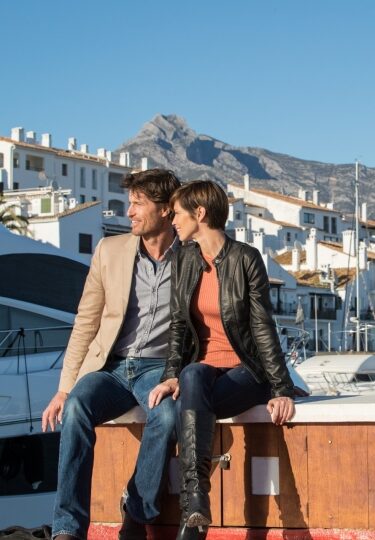There’s no end of things to do in Spain. This is a country of astonishing cultural wealth, from magnificent castles and palaces that date back hundreds of years to world-famous wines, rich cuisine, and extraordinary art.
Architecture, hiking, beaches, markets, music and dance; Spain delivers all this and more in style. There are enormous regional variations, too, from the cooler, greener north to the sun-baked plains and hills of Andalucia in the south and the volcanic Canary Islands basking in the sunshine off the coast of West Africa.
So whatever your interests, you’ll come away from this inimitable country with a new sense of wonder.
Ascend the Towers of the Sagrada Familia
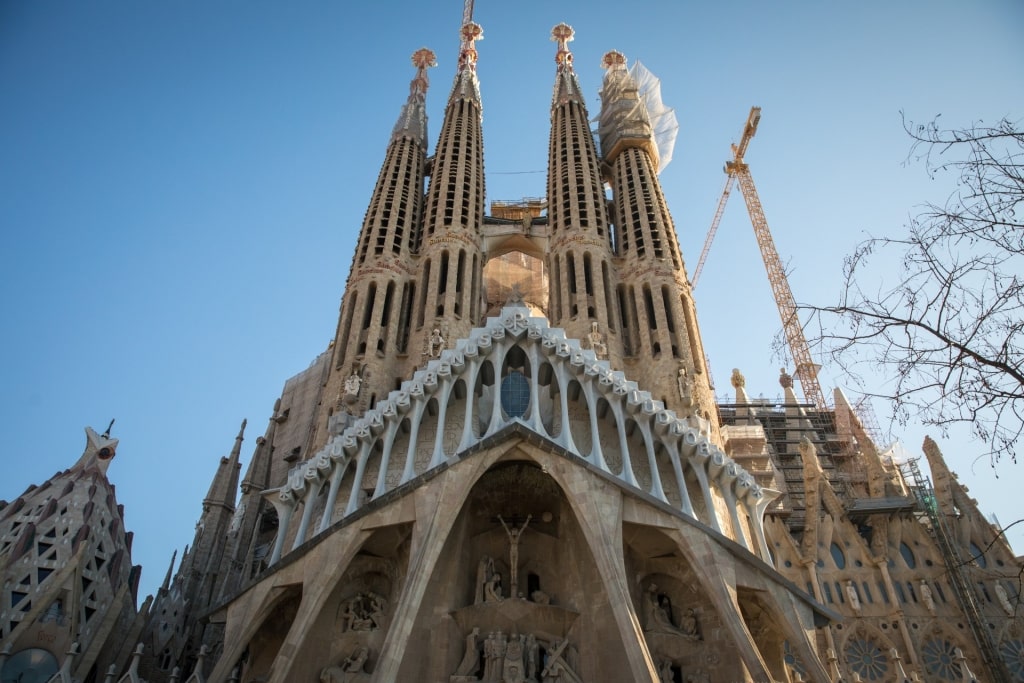
Sagrada Familia, Barcelona
Gaudi’s famous, unfinished Sagrada Familia basilica in Barcelona has to be seen to be believed. Its sheer size, as well as the attention to detail in the colorful, organic shapes, is almost overwhelming. The interior is flooded with light filtering through intricate stained glass windows, the ceiling supported by slender columns that resemble trees in a forest.
Make the most of your visit by securing tickets to head up one of the soaring towers; there are two open to the public. When you reach the top, you can step out onto a narrow balcony and see one of the best views in Barcelona—the entire city stretched out below, the Mediterranean glinting in the distance and the coastal mountains fading in the heat haze.
You will ascend the towers by elevator, mercifully, as there are more than 500 narrow steps. However, you do have to walk down, so bear this in mind before committing.
Gaze at the World’s Most Beautiful Moorish Palace
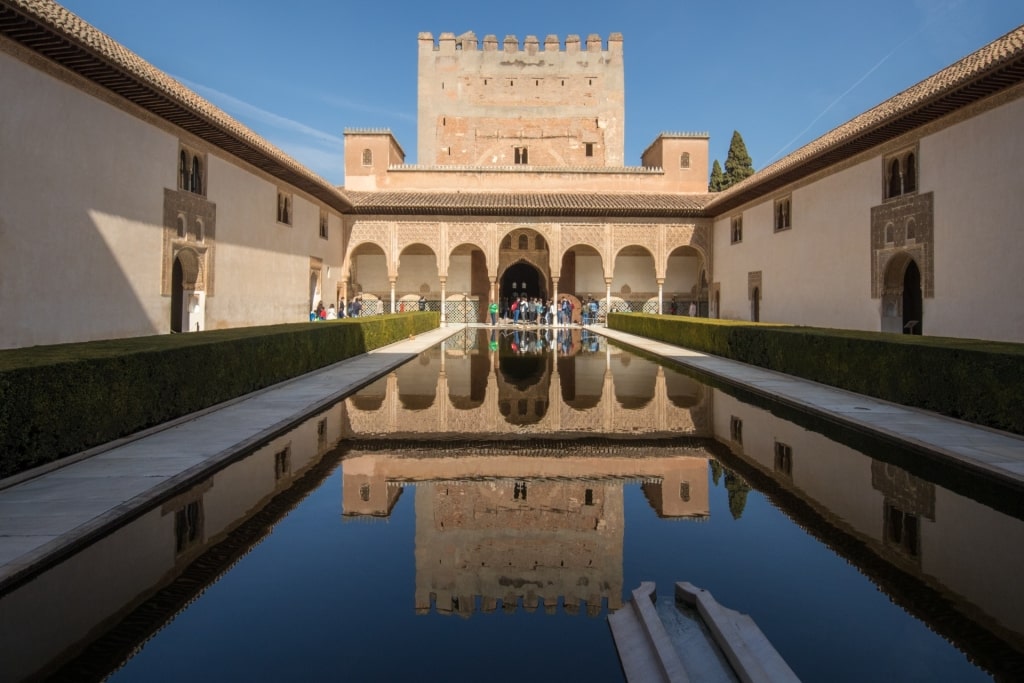
Alhambra, Granada
Most of the Iberian peninsula was occupied from the 8th to the 15th centuries by the Moors, assorted Muslim tribes from North Africa. These dynasties have left behind an extraordinary legacy, ranging from place names and language to culinary influence and architecture.
One of the most dazzling Moorish palaces is the Alhambra, situated on a hillside overlooking Granada, a day trip from Malaga.
The palace was built over a period of 600 years starting in the ninth century and was a town in its own right, with marketplaces, Turkish baths, a harem, and three separate palaces—making it one of the most fascinating historical sites to visit today. The name “Alhambra” means “red fort” and the palace does indeed glow a dusky pink in the gentle light of early morning and evening. The snow-capped mountains of the Sierra Nevada form a dramatic backdrop.
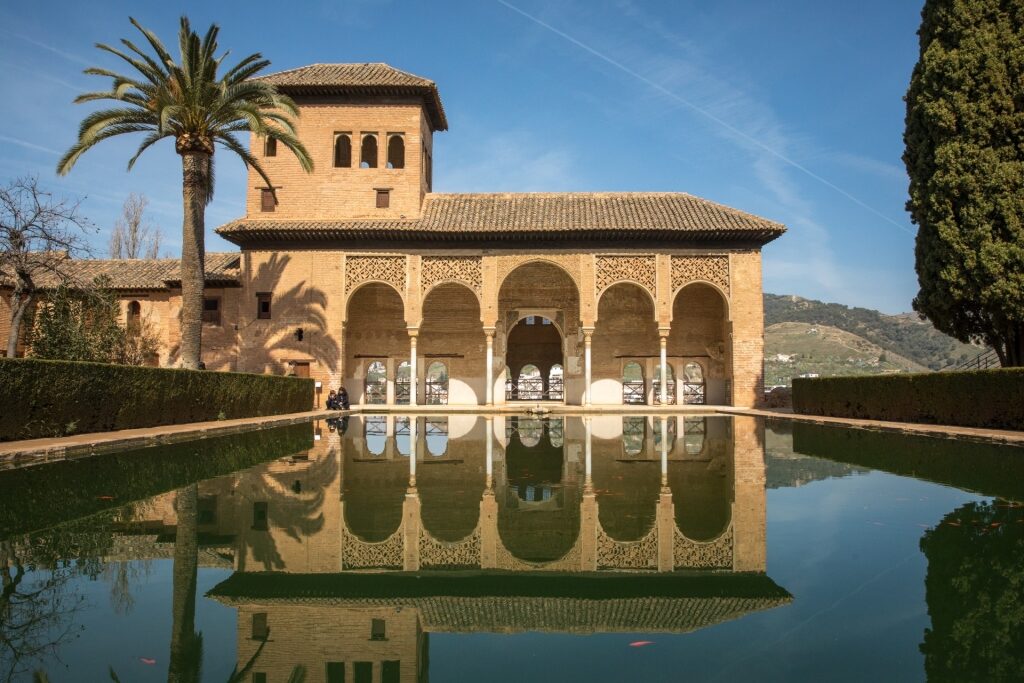
Alhambra, Granada
The complex started out as a walled citadel but soon served as the extravagantly beautiful palace of the Nasrid emirs who governed the region. Much of what you see today dates back to the 13th and 14th centuries.
A tour is essential as there’s so much detail to take in, from intricate ceilings carved out of cedarwood from Lebanon to shimmering mosaics that reflect the light. The Generalife, the former kitchen garden serving the palaces, is a serene oasis of citrus and pomegranate trees, splashing fountains, and cooling reflecting pools.
It’s worth considering the legacy of the Moors as you take in all this beauty; they introduced oranges, lemons, peaches, apricots, saffron, and rice to Spain, all of which are staples of the diet today. During their occupation, math, chemistry, philosophy, and art flourished here. Some 4,000 words and phrases in Spanish today originate from Arabic.
Marvel at Bilbao’s Guggenheim Museum
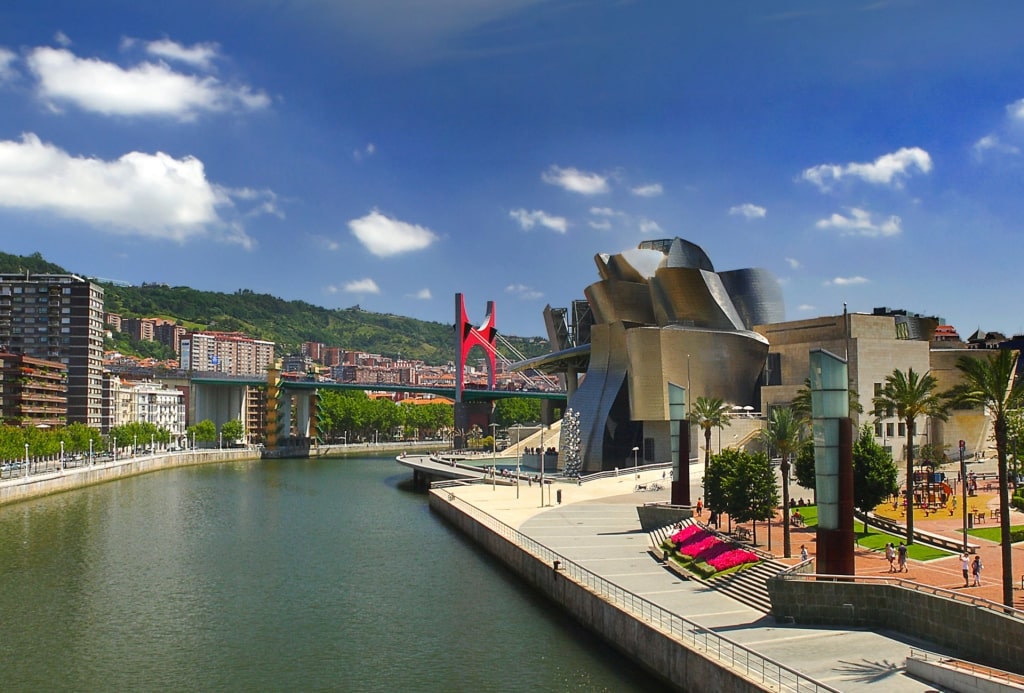
Guggenheim Museum, Bilbao
The riverfront Guggenheim Museum Bilbao is so dazzling that you’ll probably spend as much time gazing at the exterior as you will admiring the works inside. The building is a cluster of swirling titanium, glass, and limestone that gleams in the sunlight. Spend time looking at the structure and you’ll see ship shapes, cliffs, towers, and fish scales.
The Spanish museum was designed by Canadian-American architect Frank Gehry, and since its opening in 1997 has become a symbol of the city. It’s part of the global Guggenheim collection and shows a range of works from the permanent collection to changing exhibitions.
Some of the most famous elements of the permanent collection include Maman, Louise Bourgeois’ giant spider, one of the largest sculptures in the world at over 30 feet high, and Jeff Koons’ whimsical Puppy, a 43-foot terrier made entirely of flowers.
Feast at Barcelona’s La Boqueria Market
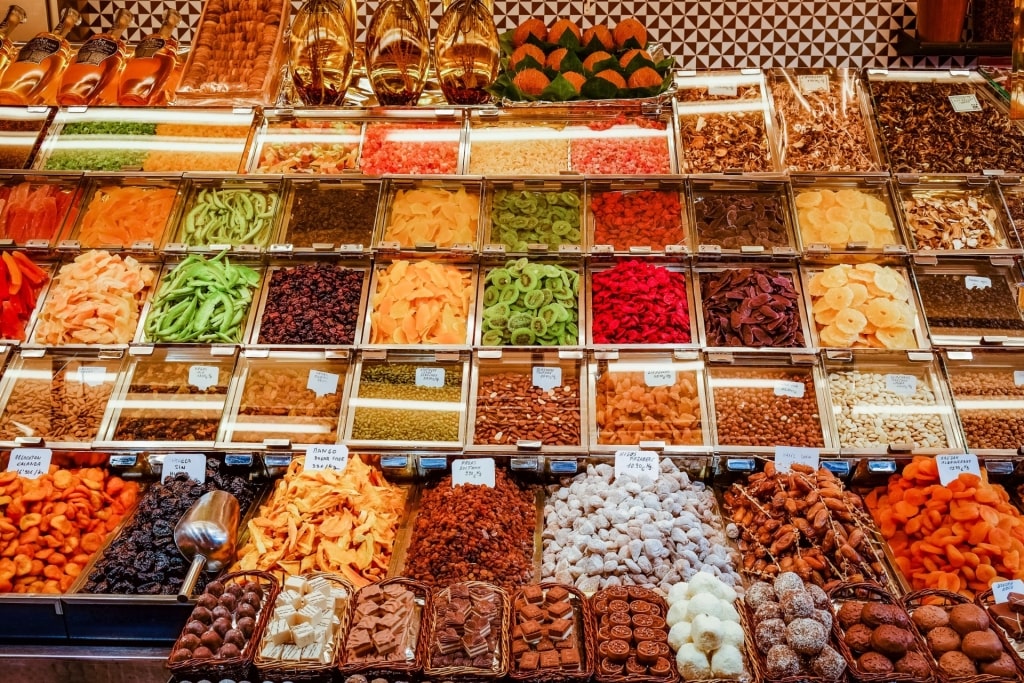
La Boqueria Market, Barcelona
Spanish markets are a riot of color, with everything from giant air-dried hams to huge wheels of cheese, mountains of red and yellow bell peppers, strings of garlic, olives, juicy peaches and nectarines, and bunches of fresh herbs on offer.
La Boqueria, an enormous undercover market on Las Ramblas boulevard, won’t disappoint. There’s been a market here since the 13th century, and today’s iteration receives some 40,000 visitors a day in peak season, many of them locals and restaurateurs. Whether or not you come here to buy some of Spain’s excellent food, it’s worth wandering around to take in the buzz and the enormous array of produce.
There are multiple bars and tiny restaurants in the market, where you can stop for a glass of cava, Spain’s famed sparkling wine, and a plate of tapas. Alternatively, stock up on fresh bread, cheese, olives, and ham and head to Barceloneta Beach for a picnic.
Taste Rioja Wines
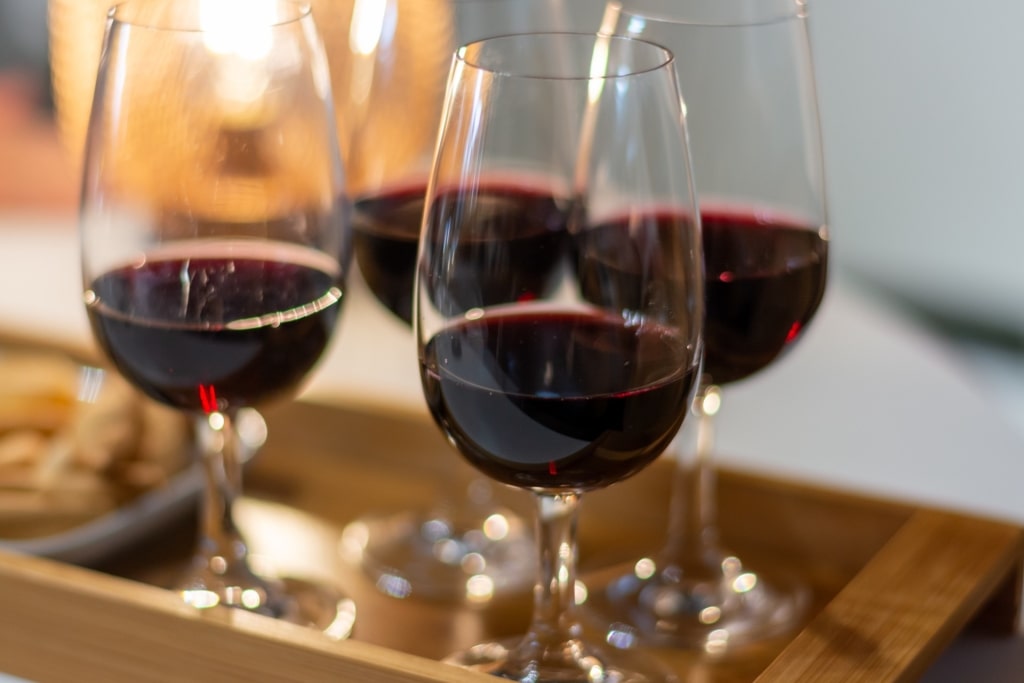
Rioja wine
Rioja wines are arguably Spain’s most famous, and the region in which they are grown is exceptionally beautiful. It’s a landscape of rolling hills, emerald fields, immaculate vineyards, and craggy mountains shimmering like a mirage in the haze in the distance.
There are more than 500 wineries in La Rioja, one of the best wine regions in the world. The region is an easy day trip from Bilbao, with everything from hiking to horseback riding, hot air ballooning, and, of course, wine tasting on offer.
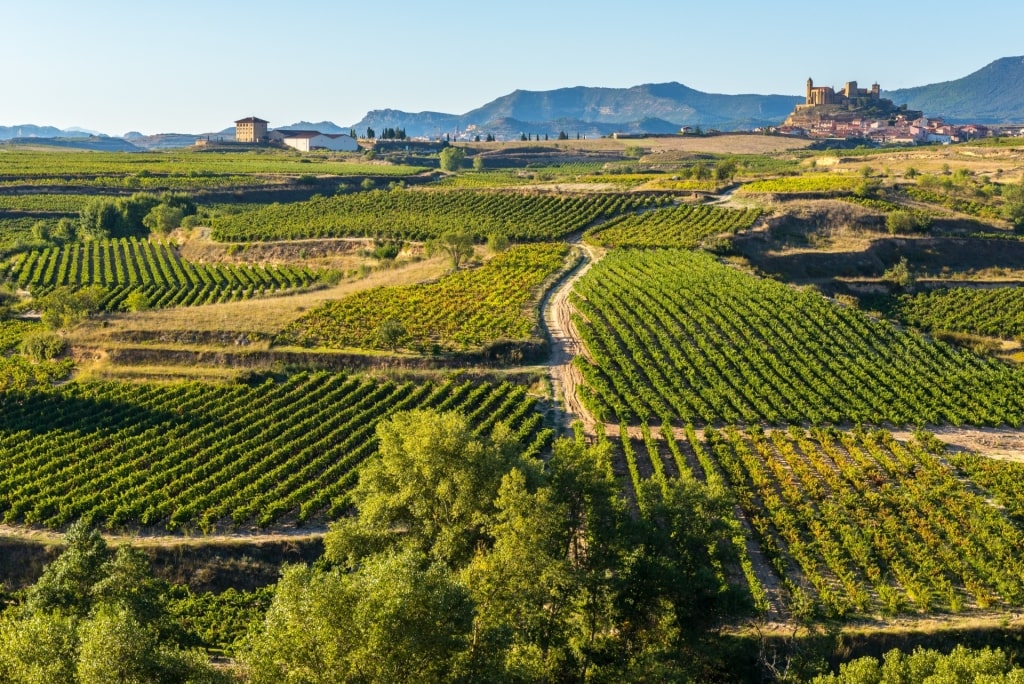
Vineyard in La Rioja
Combine a day in the vineyards with local cuisine; pintxos are the Basque region’s answer to tapas and are fun to taste with suitably paired wines. Salty anchovies, plump olives, tangy peppers, and battered squid are all popular pintxos and go perfectly with the region’s fruity, silky wines.
The epicenter of La Rioja is Laguardia, the regional capital. In this dreamy medieval town, you’ll find a jumble of Renaissance, Gothic, Baroque and Neoclassical buildings in its ancient center. Wineries are dotted all over town, the bottles stored in tunnels underground.
Explore an Excavated Roman Theater
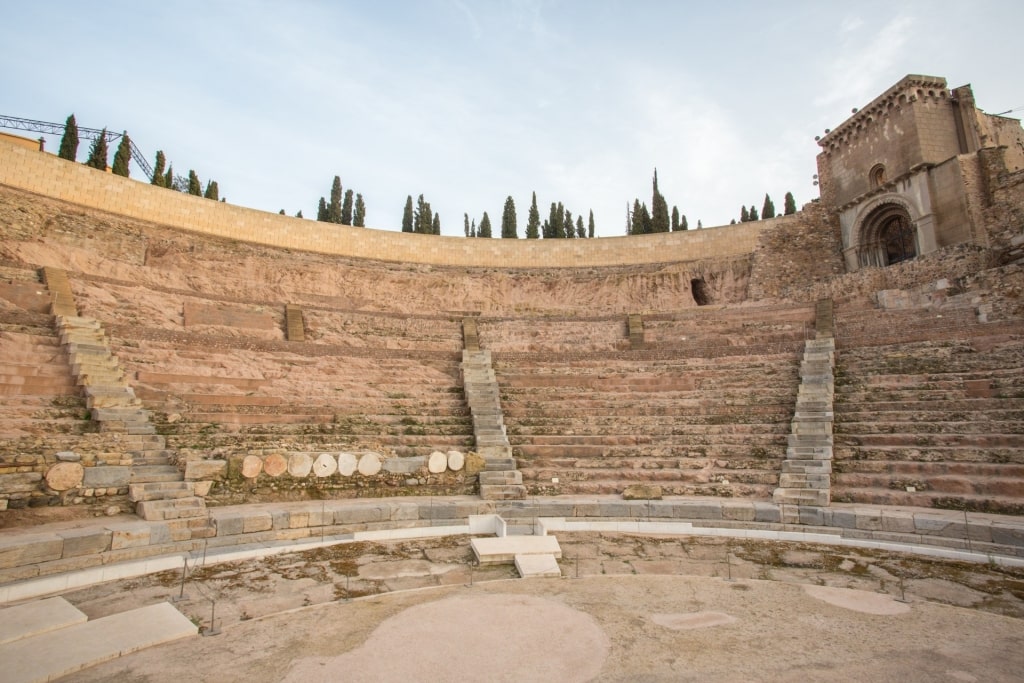
Roman Theater of Cartagena
It’s astonishing to think that Cartagena’s vast Roman theater lay undiscovered, underneath the city, until the 1980s.
The theater was built under the orders of Emperor Augustus in the first century BC. In its heyday, the amphitheater held around 6,000 spectators and was used for entertainment and political rallies. Yet as Cartagena fell under the rule of Byzantine, Visigoth, Moorish, and Christian occupiers, layer after layer of structures were built on top of the space. Both a marketplace and a bullring concealed the site over time, and the theater was forgotten.
Parts of the stonework were discovered in the 1980s as work was taking place on a ruined church that stood on the site. Excavation began in 1988, and today, the complex includes a museum showing items found during the excavation, from statues to earthenware pots. From here, you progress through an underground walkway, passing underneath modern-day Cartagena, emerging into the restored amphitheater, a truly spectacular archaeological find.
Ride a Vintage Train on Mallorca
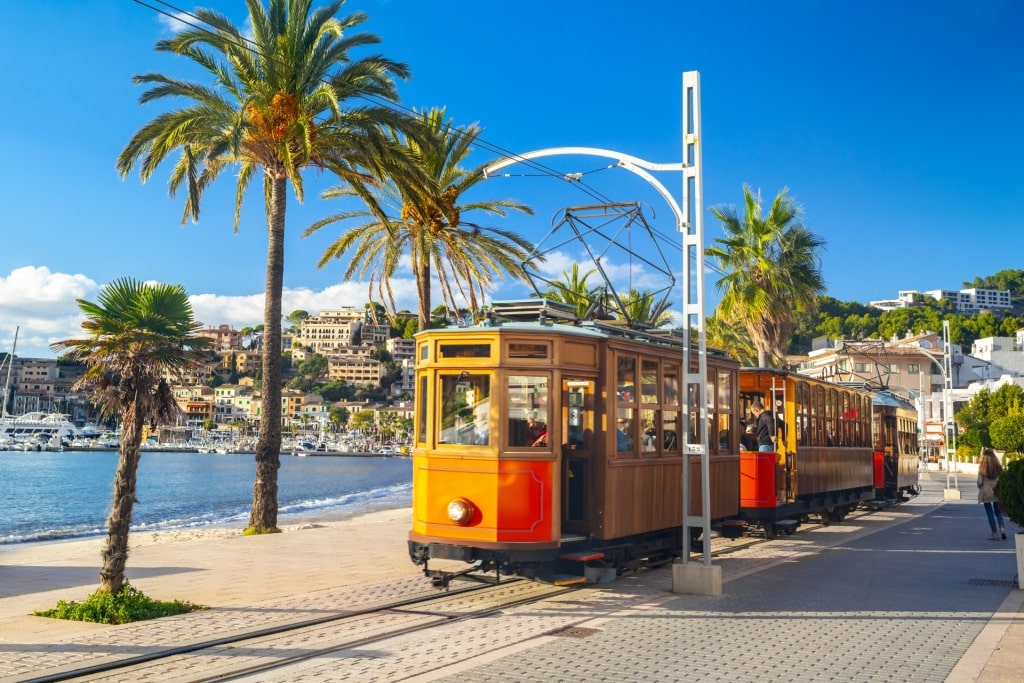
Soller Vintage Train, Mallorca
One of the best things to do on the island of Mallorca is to ride the vintage train up into the mountains from Palma, the capital, to the town of Soller.
The Belle Epoque train, all polished wood and gleaming sconces, has been in operation since 1912. The journey takes one hour as the train chugs through the suburbs of Palma into the foothills of the Serra de Tramuntana, rattling through olive and almond groves and across terraces divided by dry stone walls. It’s an absolutely beautiful journey; in fact, the whole mountain range is a UNESCO World Heritage Site.
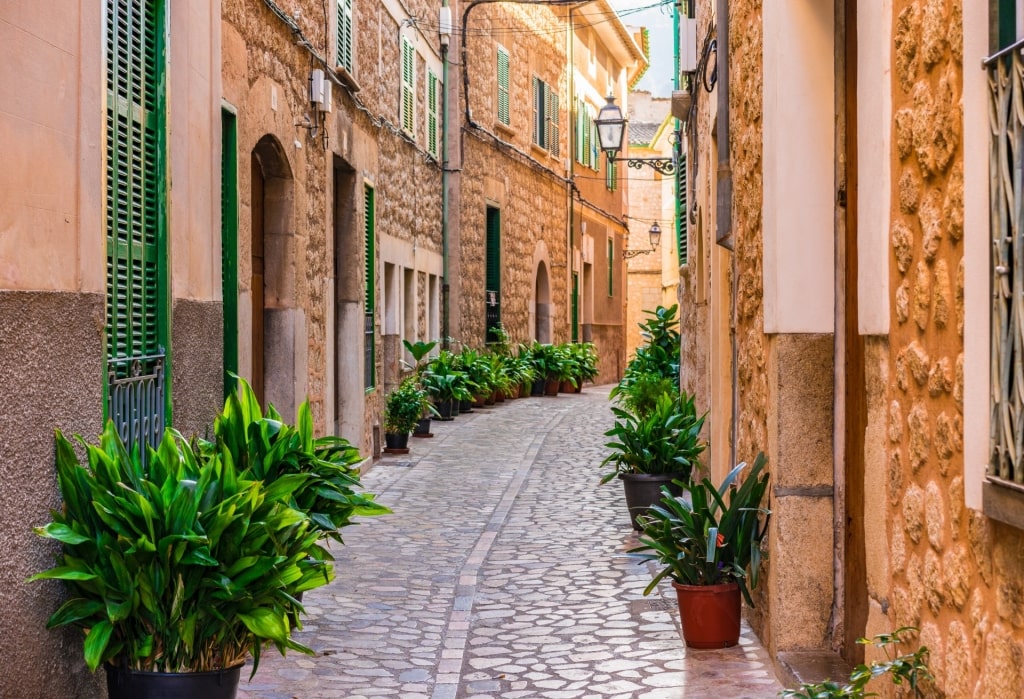
Soller, Mallorca
When you get to Soller, which is surrounded by fragrant orange groves in a sheltered upland valley, wander the cobblestone streets and admire the grand old mansions. Soller exported citrus fruit for centuries, hence the railway line, and grew wealthy on oranges and lemons. To this day, it’s one of the most desirable places to live in Mallorca.
You can ride a vintage tram from the town center down to Port de Soller, an enchantingly pretty coastal village with some excellent seafood restaurants overlooking the water.
Hike Vigo’s Pristine Cies Islands
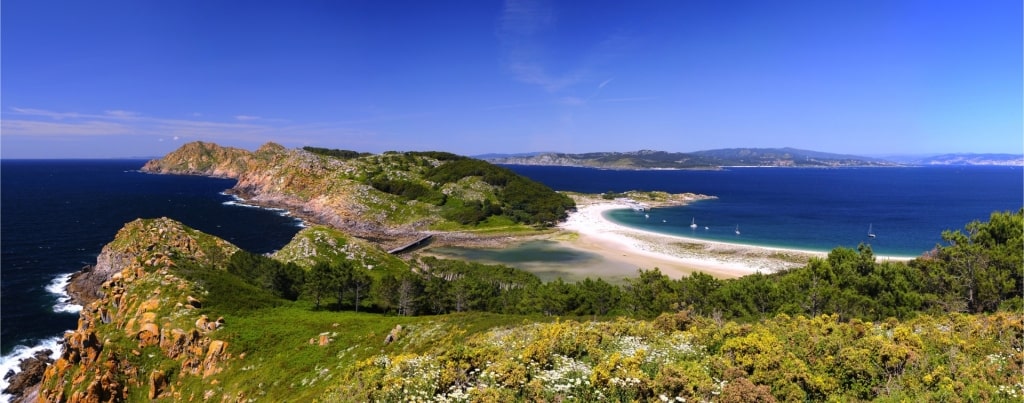
Cies Islands
The forested Cies Islands, part of the Parque Nacional de las Islas Atlánticas de Galicia, lie off the coast of northwest Spain, a 45-minute boat journey from Vigo. What’s most delightful about these three islands is that they are uninhabited and free of cars, so there’s a real sense of escape as you hike the trails. With the scent of pine on the breeze, stop to admire views of the Atlantic pounding the base of the cliffs.
The islands are fringed by long, pristine beaches. The best is dazzling white Praia des Rodas, which connects the two main islands, Monteagudo and Montefaro.
There are a few rustic restaurants on the islands for seafood, but this is also a gorgeous spot for a picnic. Bring your own food, as there aren’t any shops here.
Read: Best Beach Towns in Spain
Mingle With the Jet Set in Marbella
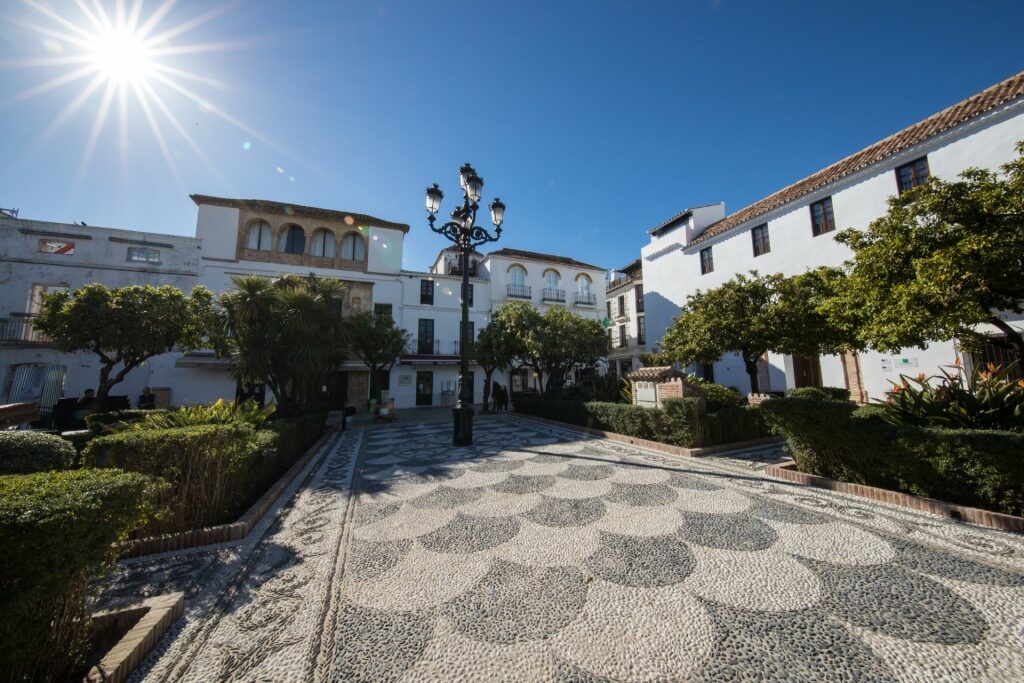
Marbella
Marbella has long been famed for its glamorous patrons, from movie stars to European and Middle Eastern royalty and stars of the golf and tennis circuits. The town, an hour’s drive east of Malaga, spreads out around the Plaza de los Naranjos, a 15th-century square lined with orange trees and handsome old buildings. Behind the urban area are velvet green golf courses, which give way to the Sierra Blanca mountains.
After exploring, you could relax on one of the many sandy beaches that front the town, or for an even bigger taste of how the A-list vacation, hop on the ferry to Puerto Banus, half an hour’s sail along the coast.
This upscale marina houses some of the biggest superyachts in the Mediterranean. The port has been purpose built to resemble a whitewashed Andalucian village, although there’s little village-like about the designer boutiques and high-end bars here.
See the Holy Grail
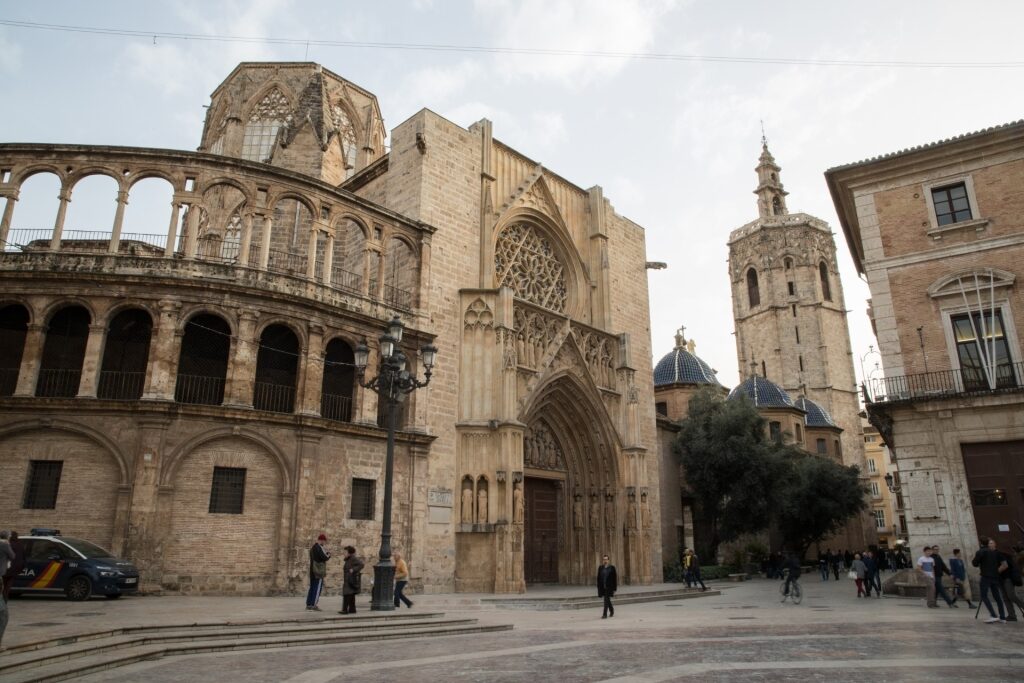
Valencia Cathedral, Valencia
One of the best things to do in Valencia is to visit its imposing cathedral, which was built on top of what was first a Roman temple and later, a mosque, as is typical in much of Spain. The cathedral, which dates back in part to the 13th century, is Gothic in style, with elements of Romanesque and Baroque.
While it holds many priceless treasures, the one item pilgrims wait patiently in line to see is the Holy Grail, believed to be the actual cup from which Jesus drank at the Last Supper.
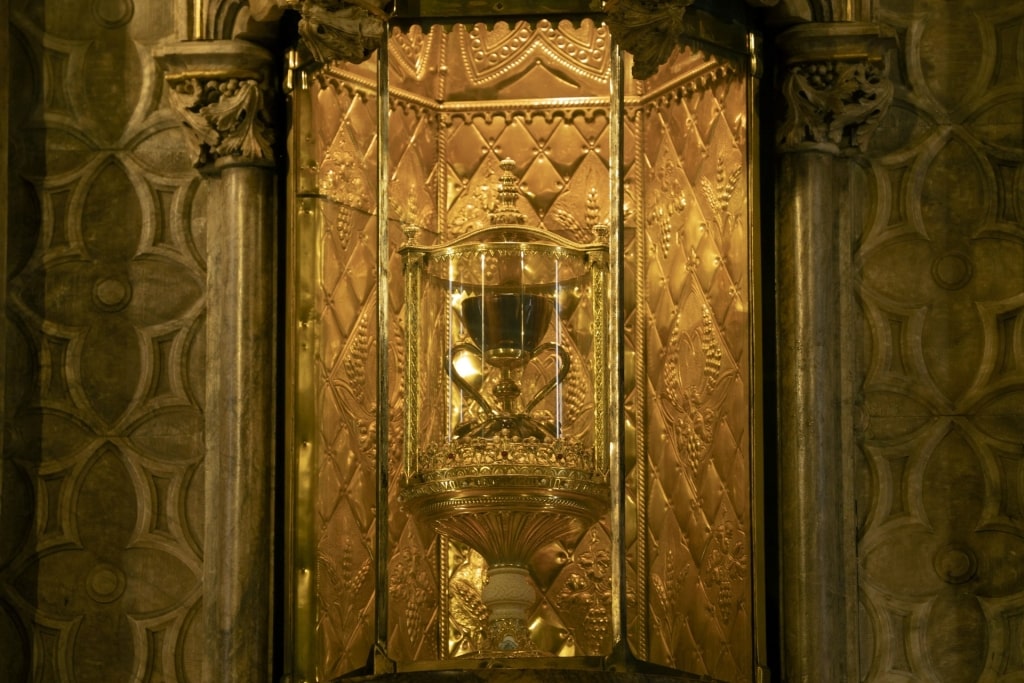
Holy Chalice, Valencia Cathedral
This Holy Chalice is made from agate and is believed to have originated in the Middle East. Its route here was complex. St. Peter is believed to have brought it to Rome, where the popes of the era kept it safe.
Avoiding persecution, Saint Sixtus II sent it to Huesca, in Spain, in the year 258 AD, and over the centuries when Spain was under Moorish occupation, it was hidden in the Pyrenees. Later, in 1424, King Alfonso the Magnanimous brought the chalice to Valencia.
You may have to wait in line to see the chalice, but this is an awe-inspiring and deeply thought-provoking piece of history.
Throw Snowballs on Spain’s Highest Mountain
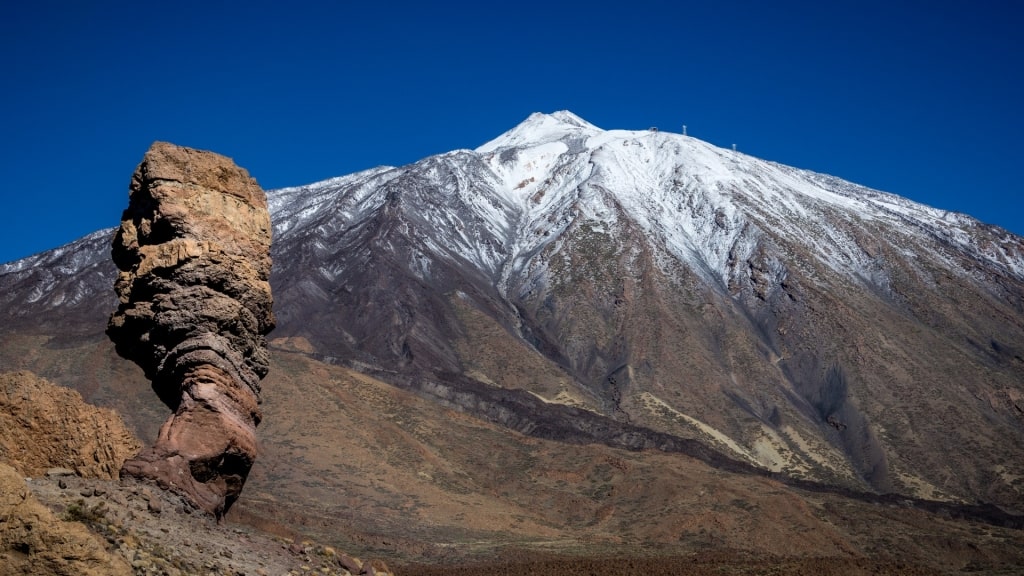
Mount Teide, Tenerife
Mount Teide, the snowy peak of which dominates the skyline of Tenerife, is Spain’s highest mountain at 12,198 feet. But there’s more to its impressive statistics. This strato-volcano rises 24,600 feet from the ocean floor, making it the world’s third-tallest volcano.
The peak of the volcano is covered with snow for part of the year, so you can take a trip up there, throw a snowball, and be back on the beach in the afternoon if you so wish. The easiest way to ascend Teide is via the cable car, which whisks you over stark volcanic landscapes in eight minutes.
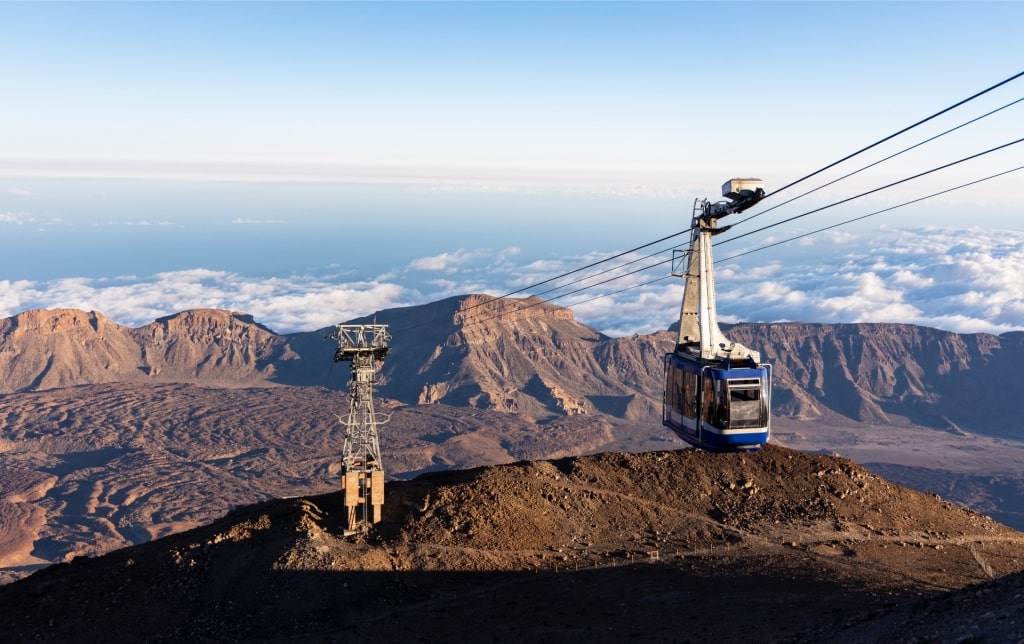
Mount Teide Cable Car, Tenerife
From La Rambleta, the top station, you can walk up one of the trails in under an hour, if you obtain a permit first. But bear in mind that the altitude may have an effect—and it’s a lot colder up here than down on the coast. The views, however, extend forever as the air is so clear; on a perfect day, it’s claimed that you can see all of the other Canary Islands from the summit.
Read: Best Things to Do in Tenerife
Taste Paella
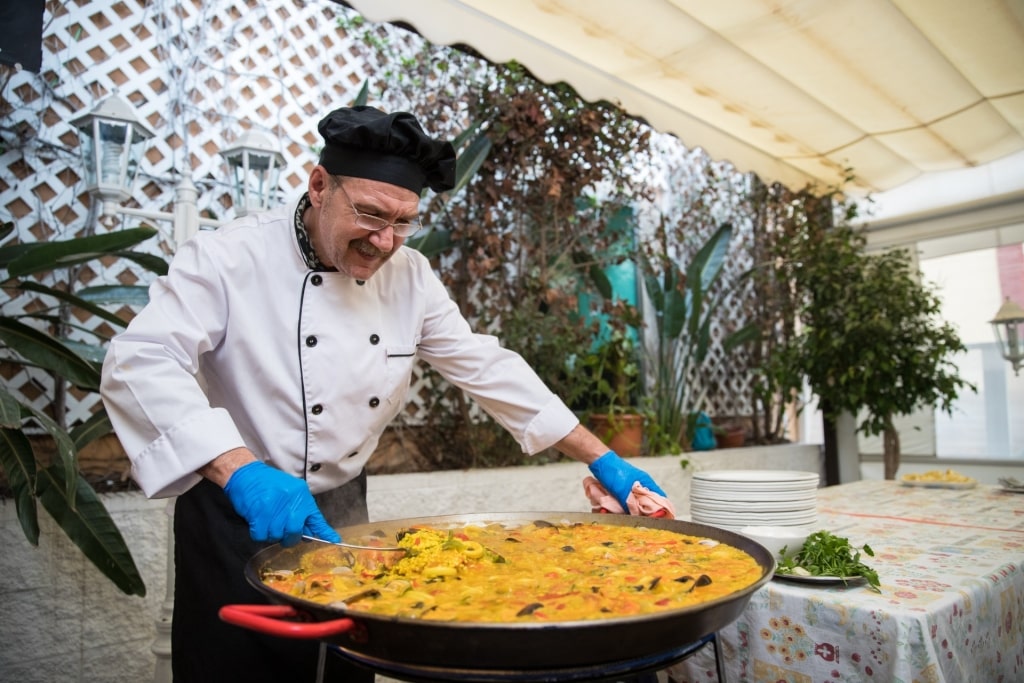
Paella
Among Valencia’s many claims to fame is the fact that it’s the home of paella. You’ll see paella restaurants everywhere, and these are not just a tourist attraction; locals often leave for a lunchtime paella during the working week or linger over a long lunch at one of Spain’s beaches on weekends.
Rice has been grown around Valencia since the time of the Moors, as the conditions here are ideal; in fact, “arroz”, the Spanish word for rice, has Arabic origins. Paella originated as an affordable lunch for laborers in the fields, who would cook up rice with anything available to them, hence the tendency to add proteins like rabbit and snails.
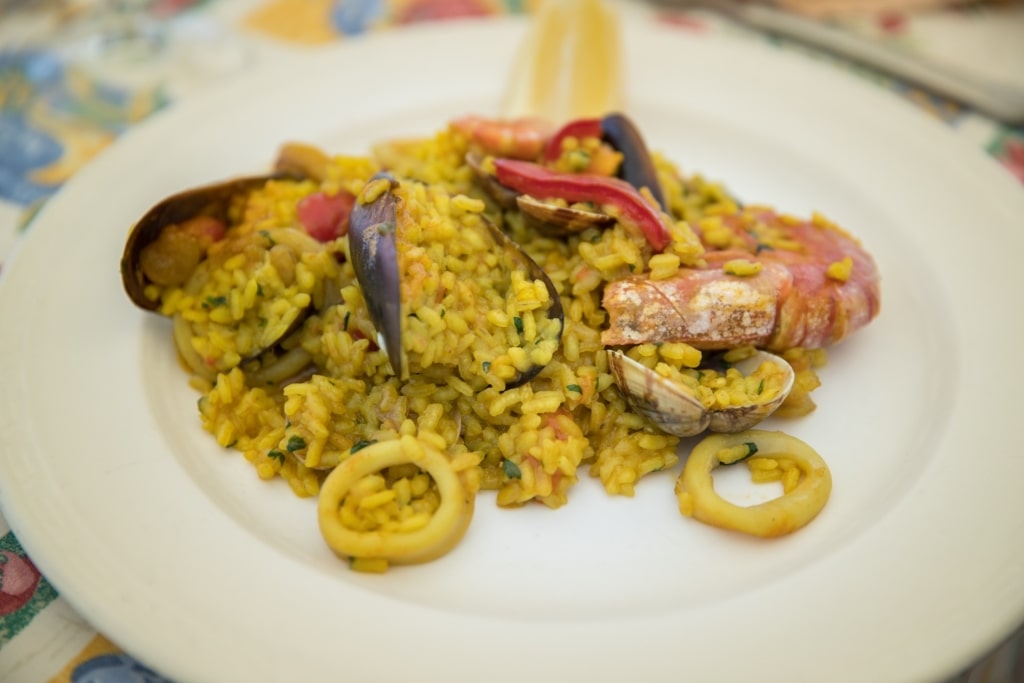
Paella
Paella should always be made with bomba rice, which absorbs the stock properly. It’s flavored with onions, tomatoes, saffron, and often bell peppers and green peas. True paella includes snails and rabbit, and sometimes chicken, although there are many variations today, including seafood and vegetarian paellas.
The secret to the perfect paella is the socarrat, the crust that forms on the bottom of the flat paella pan as the juices caramelize. This is considered the most delectable part of the dish and is only obtained if you resist the urge to stir while you’re cooking.
If you love paella, a great Spanish souvenir to take home from Valencia is a paella pan from the market, as well as some bomba rice and saffron.
Marvel at Seville’s Royal Palace
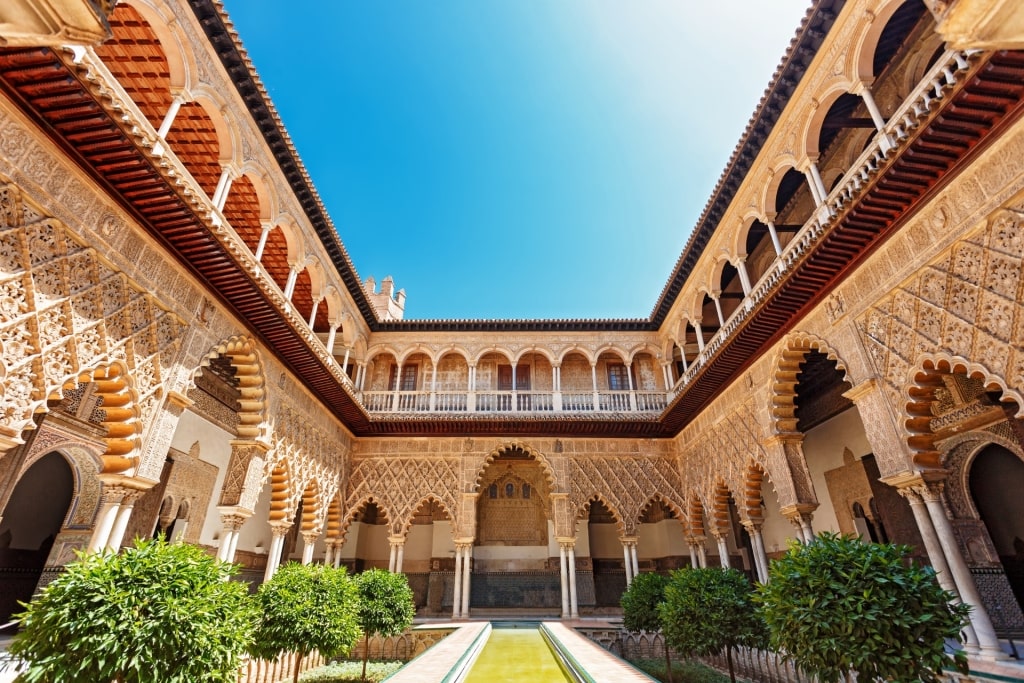
Royal Alcázar, Seville
The Royal Alcázar in Seville, to this day one of the palaces of the Spanish royal family, is the quintessential example of the Mudejar architectural style. This developed in the Middle Ages as the Moors were gradually driven out of Spain by Christians. Those Moors who did stay began to create art that blended the Arab and Islamic themes they knew with Gothic and Renaissance styles, with spectacular results.
The Royal Alcázar Palace was built in the 10th century as a fortress, with different sections added over the centuries. Any tour will show you the 14th-century Palacio de Don Pedro, all exquisite mosaics and carvings, leafy gardens, and lavish salons.
One of the most intricate spaces in the complex is the Salón de Embajadores, a square room in which every inch of the walls is elaborately carved, a gold dome gazing down on the scene. This was the throne room of the 14th century King Don Pedro I, used to receive important guests.
Read: Best Things to Do in Seville
Stroll in the Sand Dunes at Maspalomas
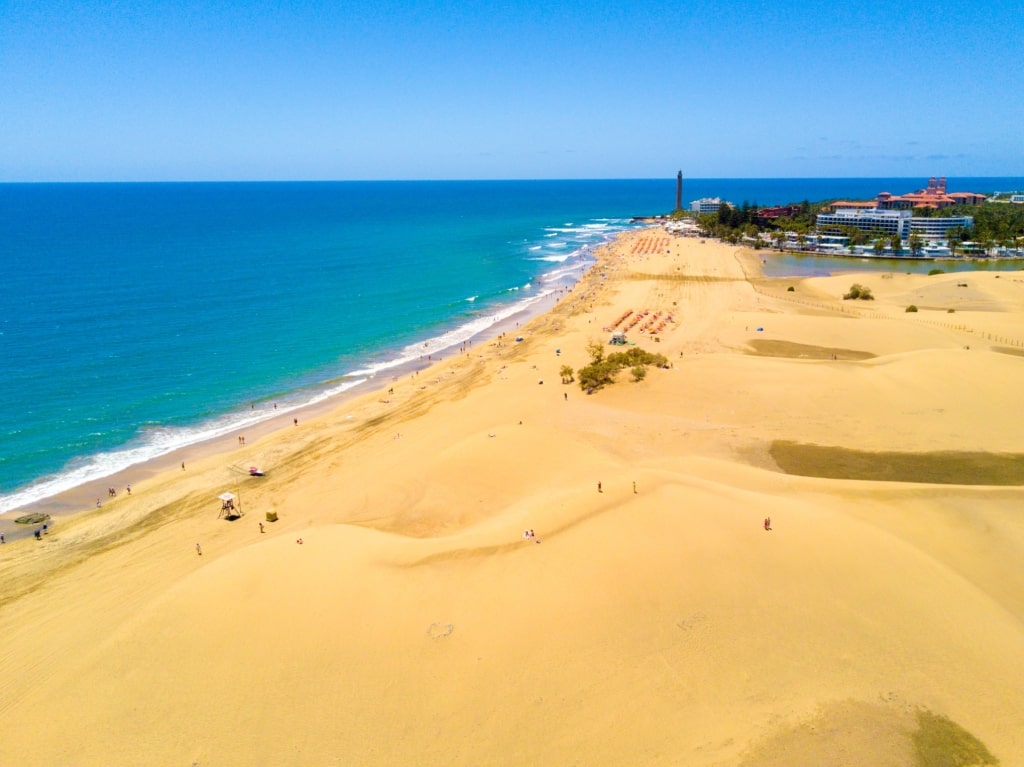
Maspalomas, Gran Canaria
On the southern shore of Gran Canaria island, you’ll have a taste of the Sahara in the rippling sand dunes, which cover 400 hectares. The dunes, sculpted by the wind and ever-shifting, are protected as a nature reserve and give way to endless golden sandy beaches, some of the most beautiful in Europe.
The dunes are overlooked by the 180-foot Maspalomas lighthouse, which started guiding ships in 1890. The dunes consist of three different ecosystems: Palmeral, or palms; Charca; which means pond and is a haven for migratory birds; and Dunas, the dunes.
You can sunbathe and swim here on one of the Canary Islands’ best beaches, or simply sit and watch the dazzling stunts of the kite surfers skimming over the waves. A good way to appreciate the natural beauty of Maspalomas if it’s not too hot is to walk the coast path or follow the trail over the dunes from Maspalomas Beach to neighboring Playa del Ingles.
Admire Lanzarote’s Striking Architecture
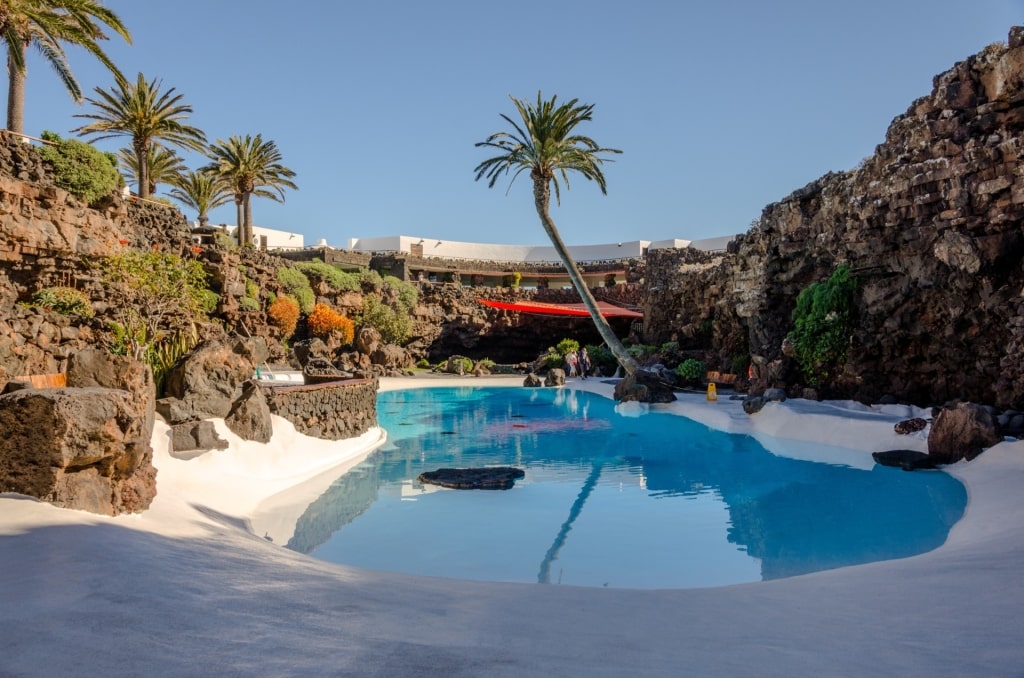
Jameos del Agua, Lanzarote
The curvy white architecture of Lanzarote is defined by the work of César Manrique, a locally-born artist and early sustainability pioneer. Manrique worked with the island’s government in the 1960s to develop an aesthetic for the island: white, sugar cube houses on which even the woodwork reflected the colors of nature, green and blue. You’ll see these color schemes everywhere.
You’ll see Manrique’s work everywhere, too; at the Museum of Modern Art (MIAC) in the capital, Arrecife, complete with pieces by Picasso and Miró; and the Jardin Cactus, where 4,500 cacti from all around the world are displayed on terraces of black volcanic stone.
In the north of the island, Manrique’s dramatic Jameos del Agua is a restaurant and concert hall that blend with black volcanic rock in an ancient lava tube. A fern-draped grotto forms the entrance to the tube, which leads to an atmospheric underground lake.
Discover Tapas
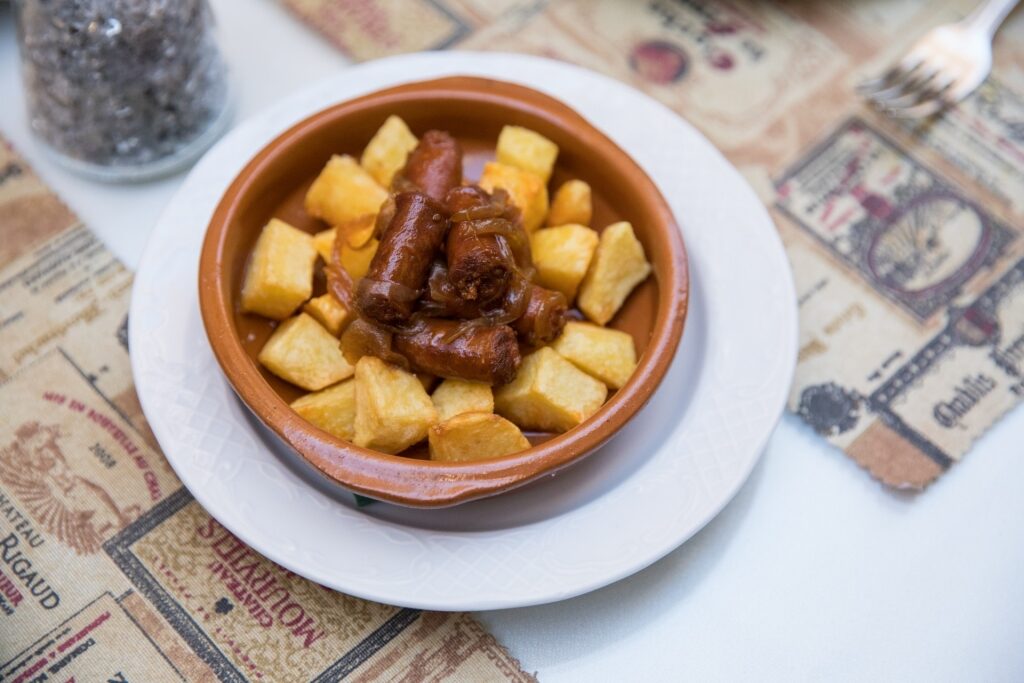
Tapas
No visit to Spain is complete without trying tapas, small plates of food designed to be shared and served either as a snack or an entire meal. Tapas originated in Andalucia; in the Basque country in the north of Spain, a similar concept is called pintxos, although these are smaller, bite-sized snacks typically served on cocktail sticks.
Tapas means “tops” or “lids” and were originally small snacks placed on a small plate on top of a glass at the bar. Whether this was an act of generosity, a practical means of keeping the flies off, or a ruse to offer the customer a salty snack to increase their thirst and likelihood of buying another drink is debatable.
There’s virtually no limit to what might be served as tapas. Some of the most popular are patatas bravas, which are cubed, fried potatoes with a tomato sauce; creamy croquettes with ham or chicken; and shrimps sizzling in hot, garlic-flavored oil. Cold dishes include jamon iberico, thinly sliced, air-dried ham; salty Manchego cheese dipped in runny honey or quince jam; and a thick wedge of Spanish omelet, or tortilla.
Explore Barcelona’s Modernista Architecture
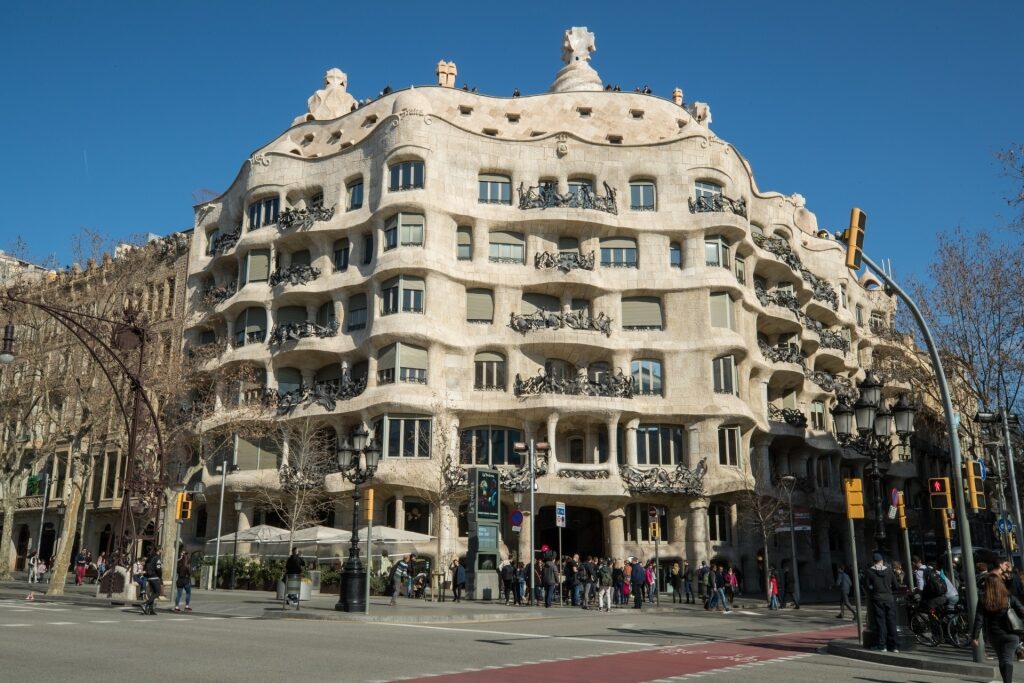
La Pedrera, Barcelona
Catalunya’s most famous architect is without a doubt Antoni Gaudí, the genius behind Barcelona’s Sagrada Familia, the Parc Güell, undulating La Pedrera, and the Casa Batlló house.
But Gaudí was just one of many modernista architects of the time, and Barcelona, in particular the Eixample neighborhood, is dotted with beautiful and elaborate buildings that show off the modernista style of Gaudí’s contemporaries.
As this beautiful Spanish city began to expand in the late 19th century outside the crowded Gothic Quarter and the Eixample grew, wealthy businessmen commissioned the fashionable architects of the day to build ever more elaborate houses here.
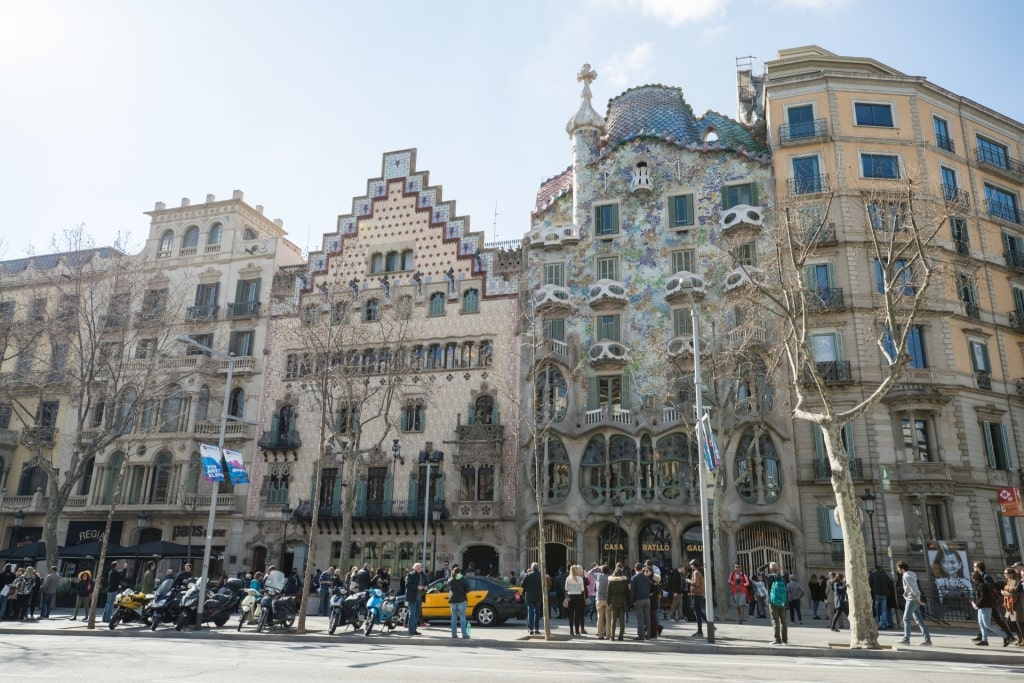
Passeig de Gracia, Barcelona
The Passeig de Gracia, the street on which Casa Batlló is located, is lined with elaborate modernista buildings. Indeed, right next to Gaudi’s curious dragon-shaped house is Casa Amatller, designed by Josep Puig i Cadafalch and built in 1900 for a chocolate magnate. Check out the apricot-and-cream frescoes, the Flemish stepped roof, and the wrought iron balconies.
Another building by Puig i Cadafalch is Casa de les Punxes, built on Avinguda Diagonal between 1903 and 1905 and reminiscent of a fairytale palace with its multiple pointed towers and elaborate balconies.
In contrast, the Fundacio Antoni Tapies, on Carrer d’Aragó, designed by Domènech i Montaner and built in the 1880s, takes inspiration from Islamic decoration. Antoni Tapies, a leading Catalan artist, launched his foundation in this building in 1984 as a showcase for contemporary art. The building is crowned by one of Tapies’ own creations, Cloud and Chair, which resembles a giant tangle of barbed wire.
Read: The Ultimate Guide to Barcelona’s Neighborhoods
Brave the Caminito del Rey
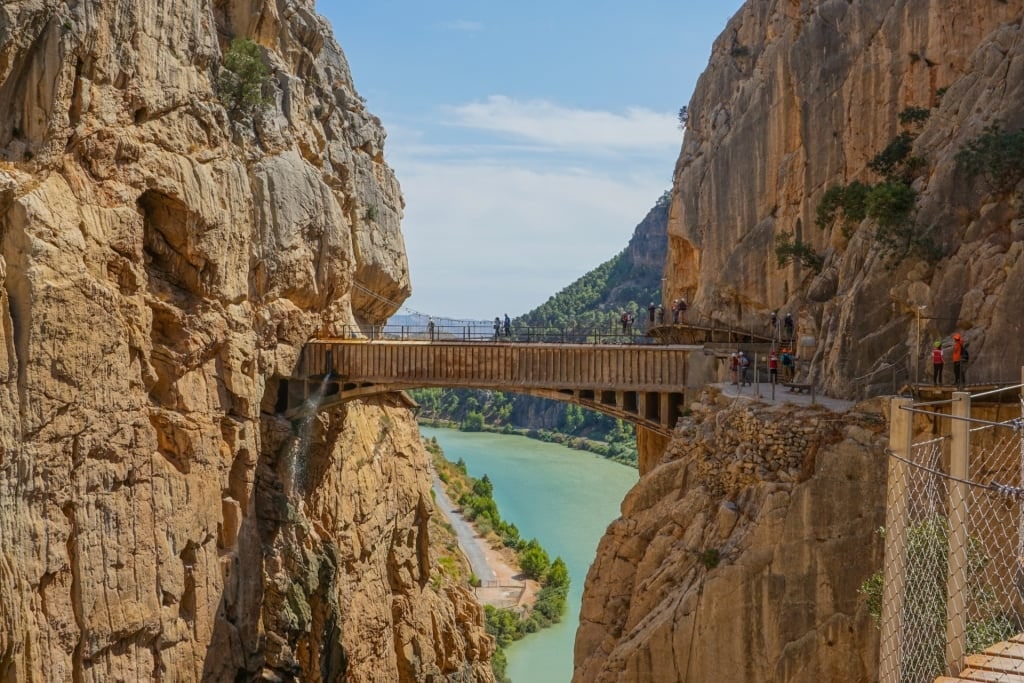
Caminito del Rey, near Malaga
Thrill-seekers can test their head for heights on the Caminito del Rey, or King’s Little Pathway, near Malaga. A mile-long section of the five-mile trail is on boardwalks suspended from the sheer rock walls of the canyon carved by the Rio Guadalhorce, the floor of the narrow gorge hundreds of feet below.
In places, the canyon is so narrow you feel as though you can touch the other side. Along the way, you could see vultures, golden eagles, wild boar, and Spanish ibex.
The Caminito used to be extremely dangerous, but between 2014 and 2015 it was completely restored and is now a popular attraction. As such, if you want to walk the Caminito, you’ll need to book in advance, as numbers are restricted to preserve the experience. Hard hats are supplied as protection from falling stones. If you have a fear of heights, it’s probably best to sit this one out.
Read: Incredible Ways to Experience Spain’s Nature
Follow the Pilgrim Trail
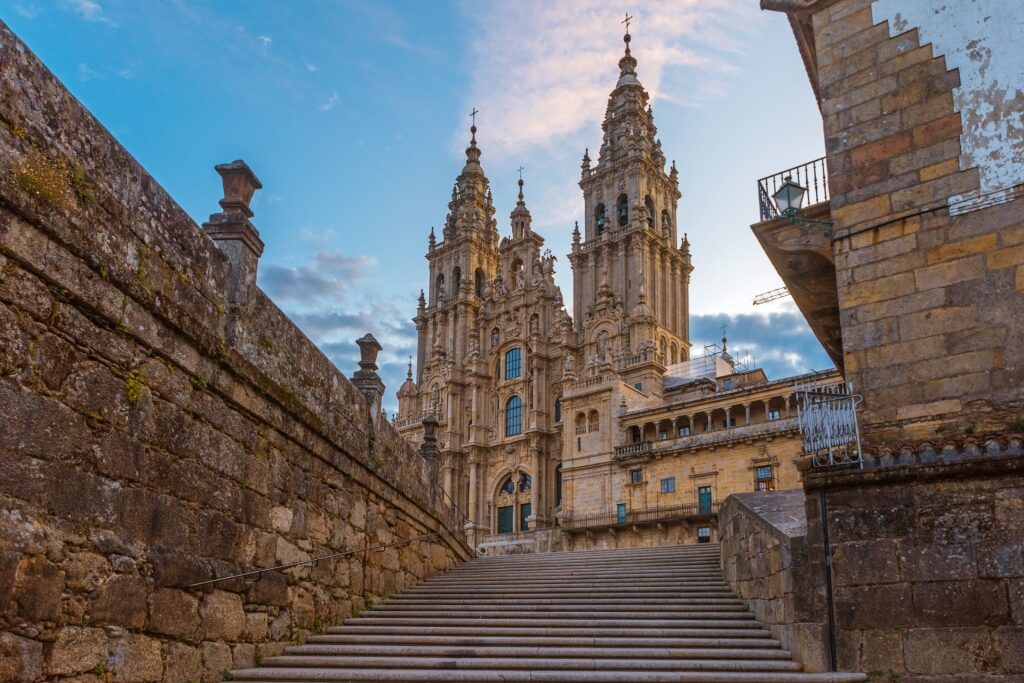
Cathedral of Santiago de Compostela, Santiago
Santiago de Compostela, the final resting place of the apostle James, is one of the most revered places in the world by Catholics. It’s where the Camino de Santiago, a series of pilgrims’ trails that crisscross Spain, France, and Portugal ends at the Cathedral of Santiago de Compostela, at the shrine of the apostle.
The Camino de Santiago has been an important pilgrimage route since the Middle Ages, with the faithful traveling on foot. Some travel by bicycle nowadays, or on horseback. As such, there’s a spiritual air in the lovely old city of Santiago, its old center completely dominated by the hulking cathedral topped with soaring spires.
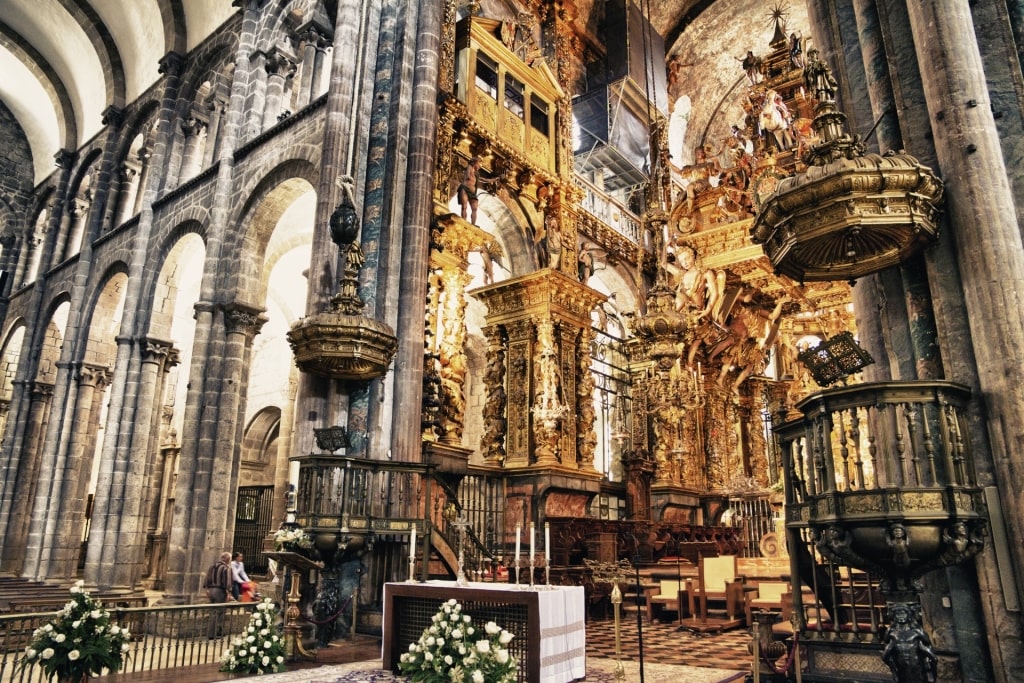
Cathedral of Santiago de Compostela, Santiago
Work on the Spanish church was started in the 11th century, in the Romanesque style, although much of what you see today is Gothic and Baroque. The shrine of Santiago, or James, the reason people come here, is under the principal altar.
An architectural highlight, though, is the magnificent Portico de la Gloria, with 200 Romanesque sculptures created in the 12th century by stonemason Master Mateo, depicting scenes from the Bible in astonishing detail. The stone has been carefully restored, and you’ll need to book an advance ticket to see this astonishing work.
Explore Andalucia’s White Towns
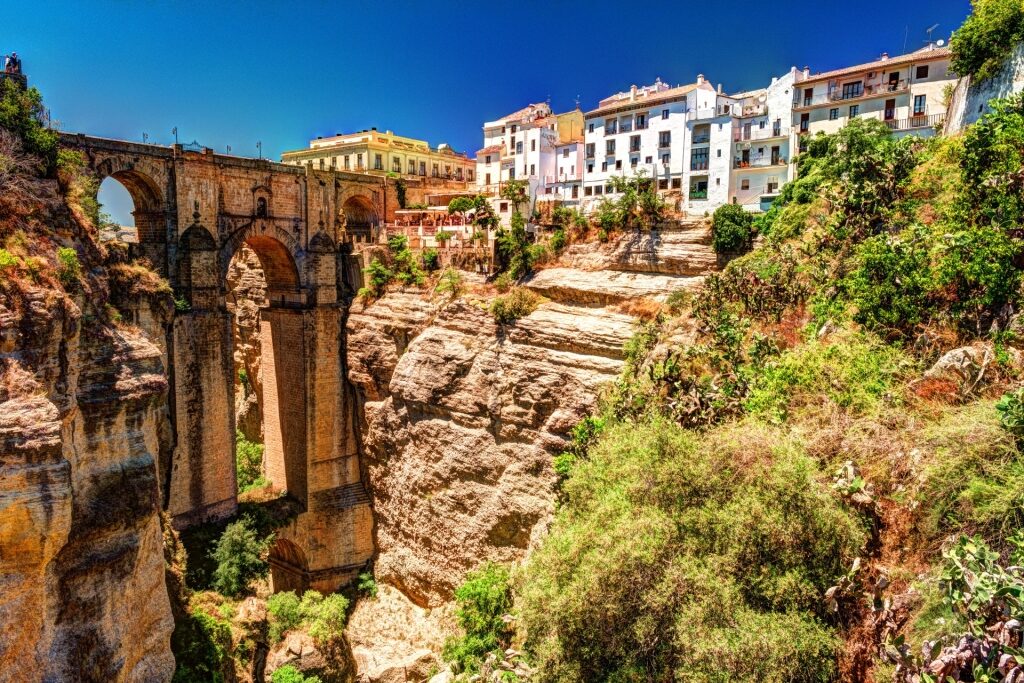
Ronda
Andalucia’s arid hills are peppered with pueblos blancos, or white towns, so called because of their ubiquitous whitewashed houses. In the heat of the south, a white house is a logical way to keep cool, as white reflects the sunlight.
Many of the pueblos blancos date back to the Middle Ages, the time of the Moors, when it was safer to build a fortified community on a hilltop than on the coast, which was easier to attack. Hilltops were more practical to defend.
Some of the most famous white towns are near Malaga; Ronda, for example, lies inland, clinging to the edges of a 500-foot-deep gorge, which is spanned by several dramatic bridges.
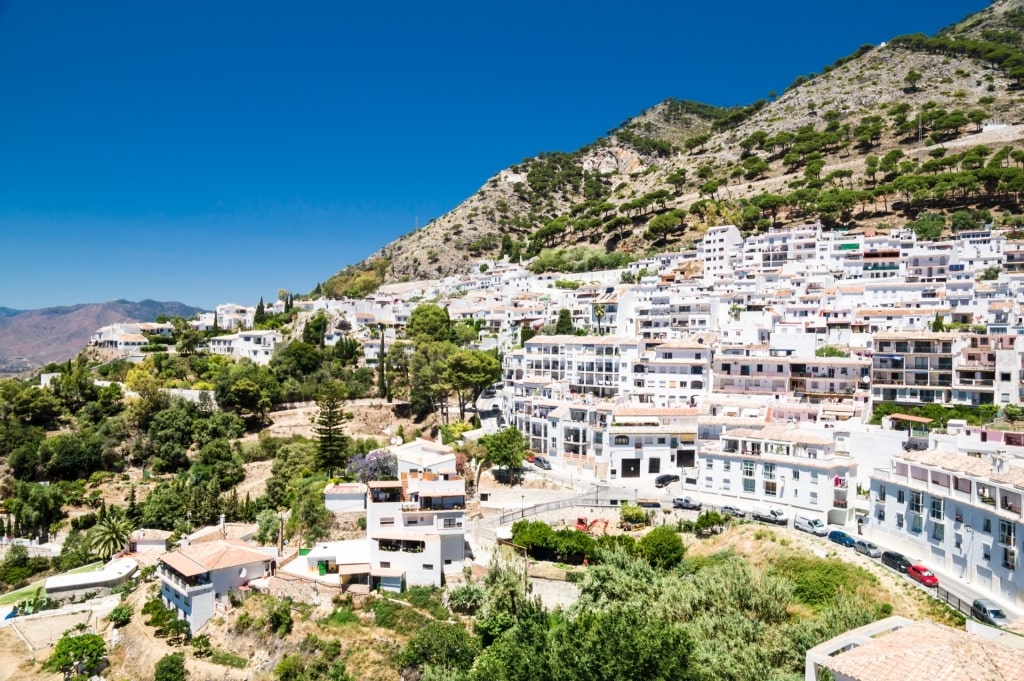
Mijas
Mijas is a delightful Spanish town 1,280 feet above sea level, characterized by bright pops of color from the sky-blue pots spilling over with geraniums and bougainvillea festooning every house. You can look down over the Costa del Sol from here—some of the original Moorish walls are still visible.
Arcos de la Frontera, meanwhile, close to Jerez, clings precariously to the top of a sheer limestone cliff. This town is a jumble of narrow alleys and archways. Check out the views from the central Plaza del Cabildo, gazing down at the Rio Guadalete, hundreds of feet below.
Learn About Sherry
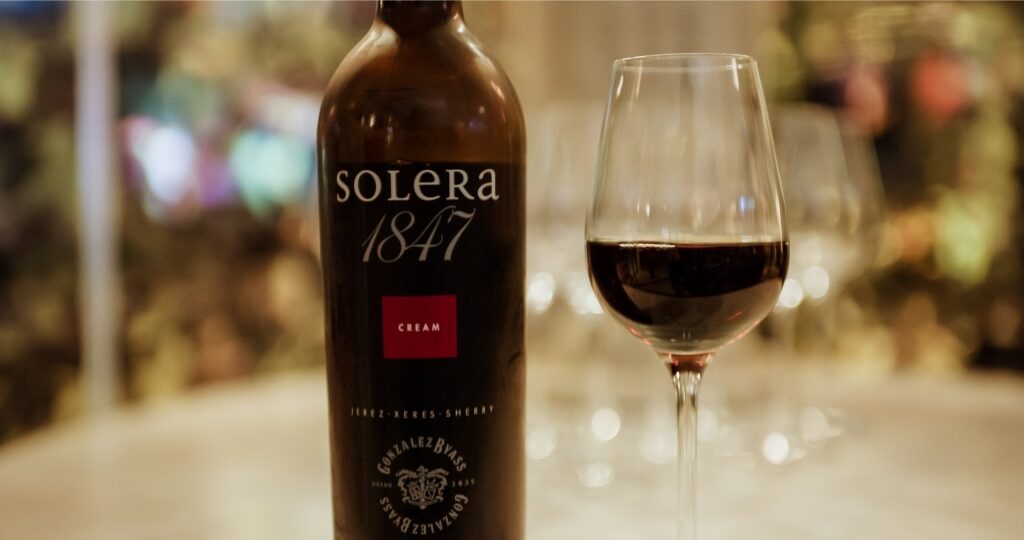
Sherry
The region around the lovely old Andalucian town of Jerez de la Frontera is lush with vineyards that produce grapes for the sherry industry. The name “sherry” derives from Jerez, which in turn comes from Arabic.
The town has stood here since the times of the Phoenicians but rose to importance under the Moorish occupation of Spain when it represented the frontier of the Moorish kingdom. You can still see the Arab baths in town and the Alcázar, built by the Moors.
The thing to do in Jerez is to taste sherry, a fortified wine which comes in many different versions, from dry wines served chilled to honey-like sweet sherries that pair with dessert.
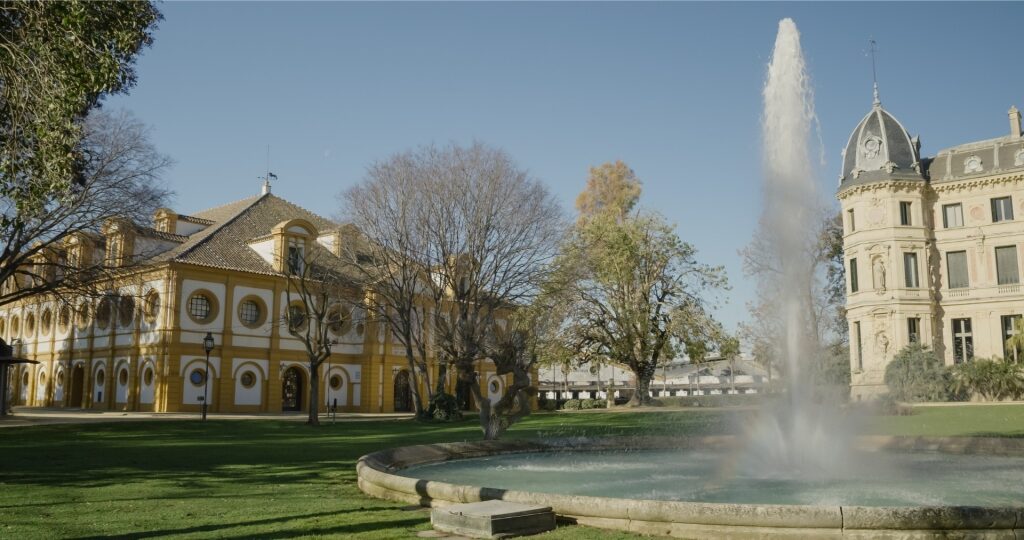
Royal Andalucian School of Equestrian Art, Jerez de la Frontera
Jerez is also famed for its magnificent thoroughbred Spanish horses, which you’ll see in fields around the city. These animals are known for their grace, agility, gentle nature, and intelligence, and as such, can be highly trained in dressage. One of the best things to do in Jerez is to take in a show at the Royal Andalucian School of Equestrian Art and marvel at the intricate “dancing” and daring leaps performed, riders and horses in perfect synchronicity.
Admire a Roman Lighthouse
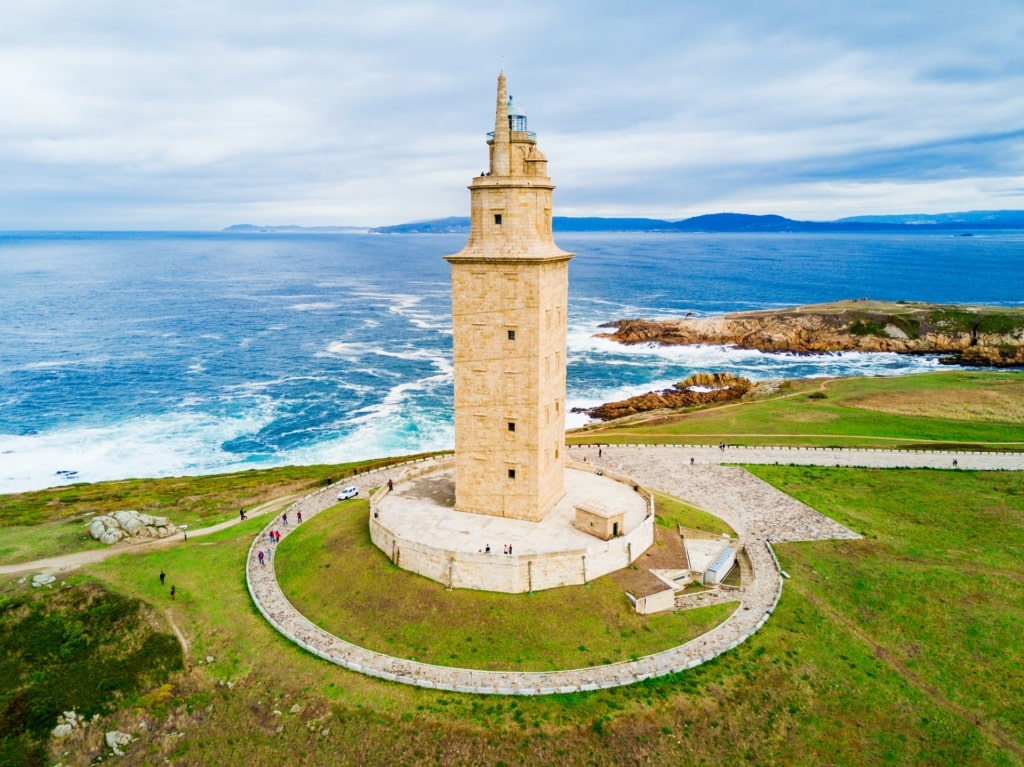
Torre de Hércules, La Coruña
The Torre de Hércules in La Coruña is a Roman-built lighthouse that is still in use 2,000 years later. It’s the only such tower worldwide to contain the original structure and still be in operation. The tower guards a headland on the northern tip of the city, buffeted by the Atlantic winds, waves foaming over the rocks at its base.
It’s astonishing to think that a light has been here to guide ships for more than 2,000 years. Only the 200 steps inside are the original Roman structure; the outer walls are more recent, dating to the 18th century. The climb is worth it as the views from the tall, octagonal tower are far-reaching. After your visit, check out the sculpture garden and the Monte dos Bicos rock carvings, which date back to the Iron Age.
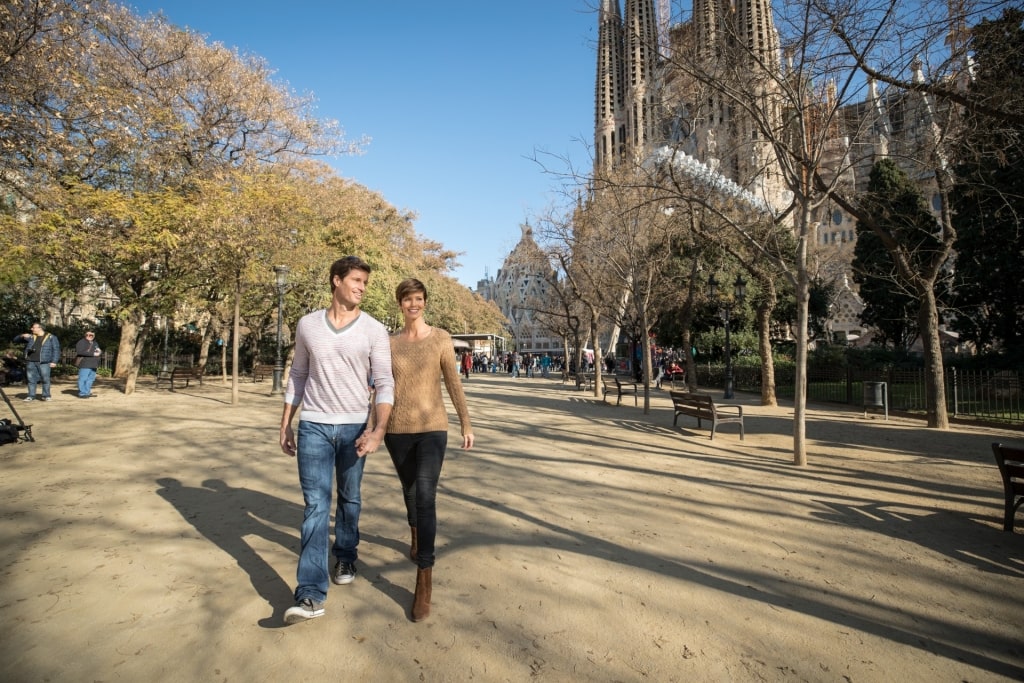
Sagrada Familia, Barcelona
Are you ready to be seduced by Spain’s culture and natural beauty? A cruise with Celebrity is the best way to take in the wonderful variety of this spectacular country. Browse our Spain cruises and plan your next big European adventure.
